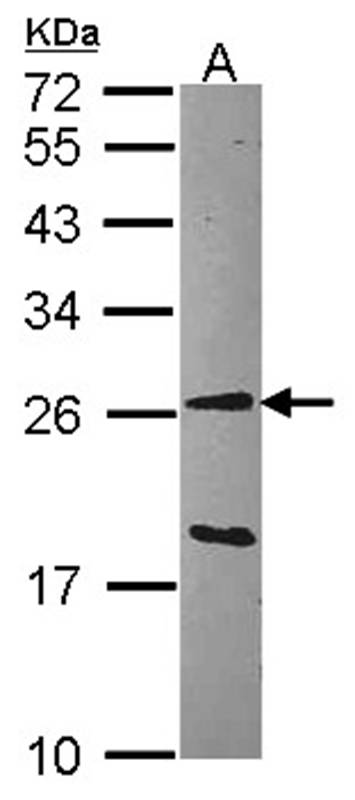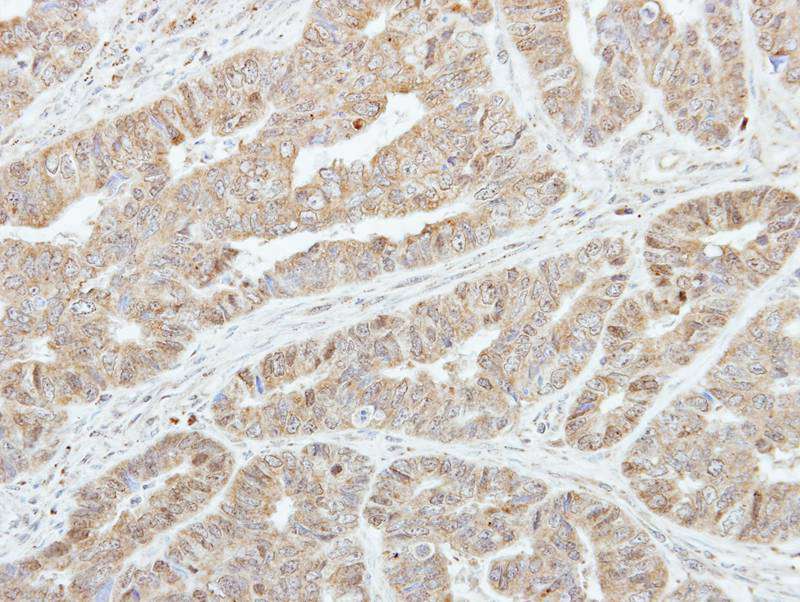Product Detail
Product NameGSTA1 antibody
Host SpeciesRabbit
ClonalityPolyclonal
PurificationAffinity purified by Protein A.
ApplicationsWB IHC IF
Species ReactivityHu
Target NameGSTA1
ConjugateUnconjugated
Other NamesGST2; GSTA1-1; GTH1; MGC131939
Accession NoSwiss-Prot:P08263
Gene ID:2938
Uniprot
P08263
Gene ID
2938;
Concentration6mg/ml
FormulationSupplied in 0.1M Tris-buffered saline with 10% Glycerol (pH7.0). 0.01% Thimerosal was added as a preservative.
StorageStore at -20˚C for long term preservation (recommended). Store at 4˚C for short term use.
Application Details
Predicted MW: 26kd
Western blotting: 1:500-1:3000
Immunohistochemistry: 1:100-1:250
Immunofluorescence: 1:100-1:200
Sample (30 ug of whole cell lysate)
A: Hep G2
12% SDS PAGE
GSTA1 antibody diluted at 1: 1000
Immunohistochemical analysis of paraffin-embedded Colon ca, using GSTA1 antibody at 1: 250 dilution.
Immunofluorescence analysis of methanol-fixed Hep3B, using GSTA1 antibody at 1: 500 dilution.
Cytosolic and membrane-bound forms of glutathione S-transferase are encoded by two distinct supergene families. These enzymes function in the detoxification of electrophilic compounds, including carcinogens, therapeutic drugs, environmental toxins and products of oxidative stress, by conjugation with glutathione. The genes encoding these enzymes are known to be highly polymorphic. These genetic variations can change an individual's susceptibility to carcinogens and toxins as well as affect the toxicity and efficacy of some drugs. At present, eight distinct classes of the soluble cytoplasmic mammalian glutathione S-transferases have been identified: alpha, kappa, mu, omega, pi, sigma, theta and zeta. This gene encodes a glutathione S-tranferase belonging to the alpha class. The alpha class genes, located in a cluster mapped to chromosome 6, are the most abundantly expressed glutathione S-transferases in liver. In addition to metabolizing bilirubin and certain anti-cancer drugs in the liver, the alpha class of these enzymes exhibit glutathione peroxidase activity thereby protecting the cells from reactive oxygen species and the products of peroxidation. [provided by RefSeq]
If you have published an article using product 22536, please notify us so that we can cite your literature.
et al,DDAH1 Protects against Acetaminophen-Induced Liver Hepatoxicity in Mice . In Antioxidants (Basel) on 2022 Apr 29 by Xiyue Shen, Saddam Muhammad Ishaq, et al..PMID:35624743
, (2022),
PMID:
35624743





 Yes
Yes



